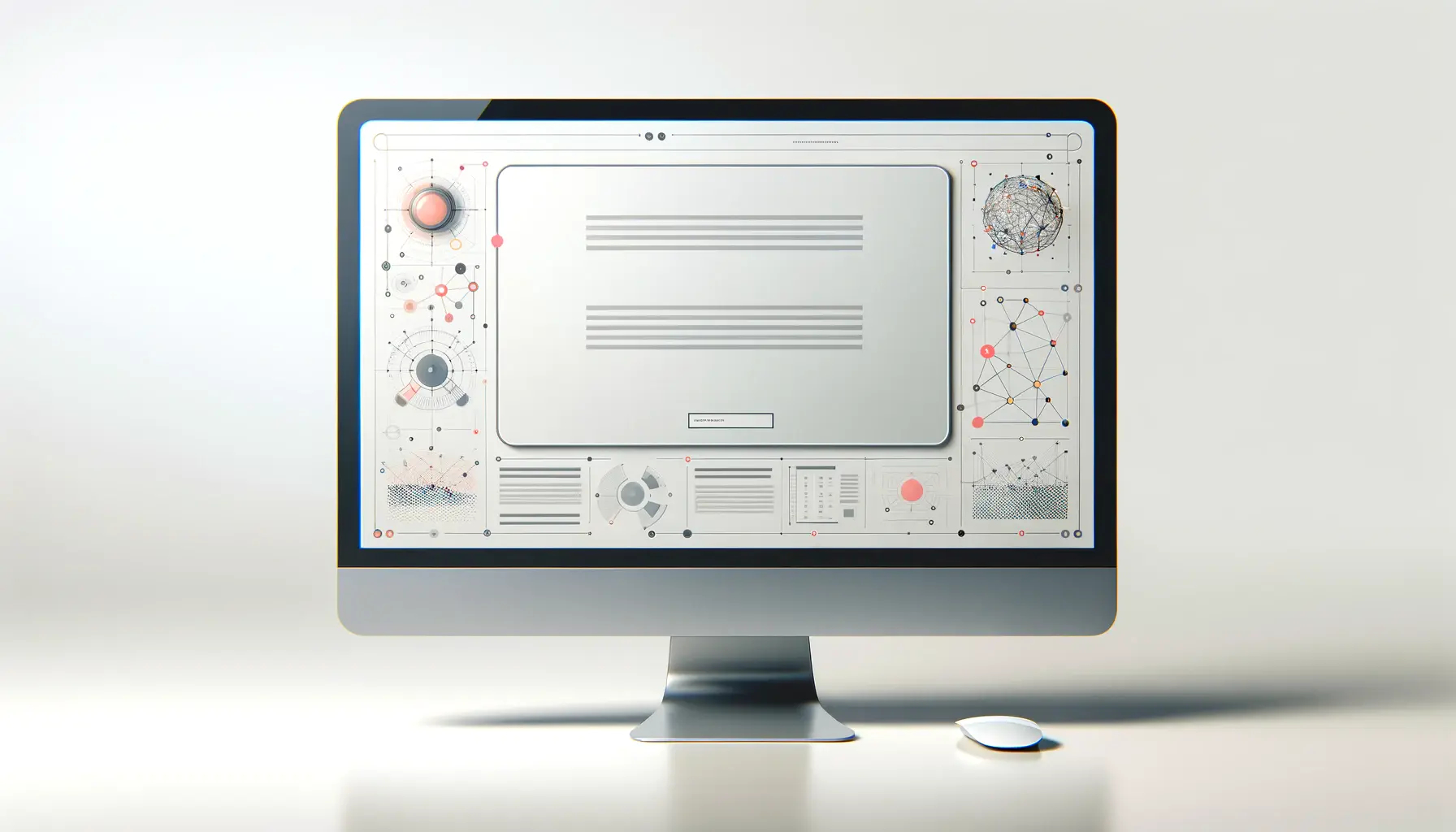The digital landscape is continuously evolving, and with it, the art and science of typography are undergoing a transformation.
Digital typography, the craft of arranging type on digital platforms, is not just about making words legible and appealing on screens; it’s about enhancing user experience, conveying brand identity, and ensuring accessibility across diverse digital devices.
As we delve into the future of digital typography, we’re poised to witness innovations that will redefine how text is presented in the digital realm.
Understanding the significance of typography in digital design is crucial.
It’s not merely about choosing fonts; it’s about creating a hierarchy, setting the tone, and establishing an emotional connection with the audience.
The right typography can elevate a design, making it more engaging and effective.
As digital platforms become more sophisticated, the role of typography in design becomes more critical, pushing designers to explore new boundaries and innovate.
- The Evolution of Digital Typography
- Embracing Color and Contrast in Typography
- Typography and User Experience (UX)
- Impact of Typography on Branding and Marketing
- Technological Advancements in Typography
- Global Influence and Cultural Sensitivity in Typography
- Environmental Sustainability in Digital Typography
- Envisioning the Future of Digital Typography
- Digital Typography FAQs
The Evolution of Digital Typography
The Shift Towards Adaptive Typography
One of the most significant trends shaping the future of digital typography is the move towards adaptive typography.
This approach tailors typographic elements to various screen sizes, resolutions, and user settings, ensuring optimal readability and user experience across all devices.
Adaptive typography goes beyond responsive design; it involves dynamic scaling, variable fonts, and context-aware layouts that adjust not just in size but in weight, spacing, and contrast based on user preferences and environmental conditions.
With the increasing diversity of digital devices, from smartwatches to massive desktop displays, adaptive typography is becoming essential.
Designers are leveraging CSS and JavaScript to create fluid typographic systems that can respond in real-time to the user’s environment.
This not only enhances accessibility but also ensures that the design’s aesthetic integrity is maintained across platforms.
Variable Fonts: A Game Changer
Variable fonts are at the forefront of typographic innovation, offering a single font file that behaves like multiple fonts.
This technology allows for seamless transitions between different font weights, widths, and styles, enabling designers to fine-tune typographic elements with precision.
The benefits of variable fonts are manifold: they reduce load times, save bandwidth, and offer unparalleled flexibility in typographic design.
As variable fonts become more widely supported, we can expect to see them play a pivotal role in digital typography.
They not only offer practical advantages but also open up new creative possibilities for dynamic and interactive text effects.
Designers can animate text, adjust typography based on user interaction, and create custom experiences that were previously impossible.
The future of digital typography lies in adaptive design and innovative technologies like variable fonts, which promise to enhance readability, user experience, and creative expression.
Embracing Color and Contrast in Typography
The use of color and contrast in digital typography is not just about aesthetics; it’s a critical factor in enhancing readability and drawing attention.
As screens become more advanced, designers have a broader palette to work with, allowing for more vibrant and diverse typographic designs.
However, the challenge lies in balancing creativity with usability, ensuring that text remains legible across various devices and lighting conditions.
When it comes to color in typography, the future points towards strategic use of bold and subtle hues to convey mood and brand identity.
Designers are experimenting with color gradients, split typography, and layered text effects to create depth and interest.
Contrast, on the other hand, is being redefined with high-resolution displays, enabling finer distinctions between text and background, thus improving readability.
Strategies for Effective Use of Color
- Color Psychology: Leveraging color psychology to evoke emotions and convey messages. For instance, blue can instill a sense of trust, while yellow might evoke energy and creativity.
- Accessibility: Ensuring high contrast ratios for text and background colors to accommodate users with visual impairments and comply with accessibility standards.
- Brand Alignment: Choosing colors that align with the brand’s identity and message, creating a cohesive visual experience across all digital platforms.
Contrast for Clarity and Focus
- Background vs. Text: Employing contrasting backgrounds to enhance text visibility, especially in designs with busy imagery or patterns.
- Font Weight and Size: Using contrast in font weight and size to establish a clear hierarchy, guiding the reader’s eye through the content.
- Interactive Elements: Highlighting links, buttons, and interactive elements with contrasting colors or effects to make them stand out and improve user navigation.
The strategic use of color and contrast in digital typography not only enhances the visual appeal but also significantly improves user experience and accessibility.
Typography and User Experience (UX)
The intersection of typography and user experience (UX) is where design meets functionality.
In the digital age, typography does more than convey information; it shapes the user’s journey, guiding them through interfaces with clarity and intention.
The future of digital typography in UX design is about creating immersive experiences that are not only visually compelling but also intuitively navigable.
As we look ahead, the role of typography in UX will become increasingly nuanced, with a focus on legibility, readability, and emotional resonance.
Designers will need to consider how typographic choices affect the overall user experience, from the initial impression to the ease of navigation and the readability of content on various devices and screen sizes.
Legibility and Readability
- Legibility: Ensuring that characters and words are distinguishable from one another, which is crucial for reading efficiency and user comfort.
- Readability: The arrangement of text in a way that makes it easy for users to understand and absorb the content. This includes considerations of line length, spacing, and font choice.
Emotional Impact of Typography
- Font Choice: Selecting fonts that evoke the right emotions and fit the context of the content, whether it’s professional, playful, or serious.
- Microinteractions: Using typographic elements in microinteractions to delight users and create memorable experiences.
Adapting Typography for Accessibility
Accessibility in digital design ensures that content is usable by everyone, including individuals with disabilities.
Typography plays a key role in accessibility, with considerations for font size, color contrast, and text spacing becoming paramount.
Future trends in digital typography will likely emphasize inclusive design principles, making digital content accessible to a wider audience.
Designers will increasingly use tools and guidelines, such as the Web Content Accessibility Guidelines (WCAG), to create typographic designs that meet accessibility standards.
This includes using scalable units for font sizes, ensuring sufficient contrast between text and background, and avoiding decorative fonts that may reduce legibility for users with dyslexia or other visual impairments.
Integrating typography with UX design principles enhances the user’s interaction with digital content, making it not only accessible but also engaging and emotionally resonant.
Impact of Typography on Branding and Marketing
Typography is a powerful tool in the arsenal of branding and marketing, offering a silent yet compelling voice to brands across digital platforms.
The choice of typeface, font size, color, and layout can significantly influence how a brand is perceived by its target audience.
As we venture further into the future, the strategic use of typography in branding and marketing becomes increasingly critical, with brands leveraging typographic design to differentiate themselves in a crowded digital marketplace.
The evolution of digital typography has provided brands with the opportunity to express their identity more dynamically and engagingly.
From website design to social media posts, email marketing campaigns, and digital advertisements, typography helps in creating a cohesive brand experience that resonates with the audience and reinforces brand recognition.
Creating a Unique Brand Identity
- Consistency Across Platforms: Maintaining typographic consistency across all digital platforms strengthens brand recognition and fosters trust with the audience.
- Personality Through Type: The choice of typeface can reflect a brand’s personality, whether it’s authoritative, playful, sophisticated, or friendly, aiding in emotional connection with the audience.
Enhancing Marketing Messages
- Emphasis on Key Messages: Using typography to highlight key marketing messages ensures they capture the audience’s attention and convey the intended impact.
- Call to Action (CTA): Typographic design of CTAs plays a crucial role in conversion rates, with clear, compelling, and visually distinct CTAs guiding users towards the desired action.
Typography in Digital Advertising
As digital advertising evolves, typography becomes an essential element in creating ads that stand out and engage the viewer.
The right typographic choices can enhance ad readability, attract attention, and significantly improve the ad’s effectiveness.
Future trends may see more personalized and interactive typographic elements in digital ads, tailored to user preferences and behaviors, making each advertising experience unique and engaging.
Moreover, with the rise of video and animated content in digital marketing, animated typography offers a new dimension to engage audiences, with moving text that captures attention and adds a layer of creativity to marketing messages.
The strategic integration of typography in branding and marketing not only enhances visual appeal but also strengthens brand identity and improves marketing effectiveness.
Technological Advancements in Typography
The future of digital typography is closely tied to technological advancements, which are set to expand the boundaries of what’s possible in typographic design.
From the development of new font technologies to the integration of typography with augmented reality (AR) and virtual reality (VR), technology is reshaping the way we think about and interact with text in digital spaces.
As technology evolves, so too does the potential for more expressive, adaptive, and interactive typography.
These advancements not only enhance the aesthetic appeal of digital content but also improve functionality, accessibility, and user engagement.
Augmented Reality (AR) and Typography
- Immersive Experiences: AR technology allows for the creation of immersive typographic experiences, where text can be overlaid on the real world, providing contextual information in an engaging way.
- Interactive Signage: AR can transform static digital signage into interactive experiences, with users able to engage with typographic content through their mobile devices.
Artificial Intelligence (AI) in Typography
- Font Creation and Customization: AI technologies are being used to create and customize fonts automatically, allowing for personalized typography that can adapt to user preferences and contexts.
- Readability and Accessibility Enhancements: AI can analyze user behavior and environmental factors to adjust typographic settings in real-time, enhancing readability and accessibility for all users.
Future Font Technologies
The development of new font technologies, such as color fonts and variable fonts, offers unprecedented flexibility and creativity in typographic design.
Color fonts, for example, incorporate multiple colors, gradients, and textures within the font itself, opening up new possibilities for expressive text.
Meanwhile, variable fonts’ adaptability to different contexts and devices makes them a key player in the future of digital typography.
As these technologies continue to develop, we can expect to see them become more mainstream, with wider adoption and support across design tools and digital platforms.
This will enable designers to push the boundaries of typographic design further, creating more engaging and personalized user experiences.
Technological advancements in typography are paving the way for more expressive, adaptive, and interactive text, enhancing both the aesthetic and functional aspects of digital content.
Global Influence and Cultural Sensitivity in Typography
As the digital world becomes increasingly interconnected, the global influence on typography is more pronounced than ever.
Typography, in its essence, is a form of communication, and in a multicultural world, it must transcend language barriers and reflect cultural sensitivity.
The future of digital typography lies in its ability to adapt to a global audience, respecting cultural nuances while maintaining a coherent brand identity and message.
This global perspective necessitates a broader understanding of typographic traditions, scripts, and the implications of type choices on a worldwide scale.
Designers are tasked with creating typographic solutions that are not only visually appealing but also culturally inclusive and accessible to diverse audiences.
Typography Across Languages and Scripts
- Multi-Script Typography: Designing for a global audience often involves working with multiple scripts, from Latin to Cyrillic, Arabic, and beyond. Each script has its own typographic conventions and challenges, requiring a nuanced approach to design.
- Language-Specific Typeface Design: The development of typefaces that cater to specific languages and scripts is crucial for ensuring legibility and cultural relevance, particularly for languages with complex scripts.
Cultural Sensitivity in Typographic Choices
- Understanding Cultural Context: Typography can carry cultural connotations, and what works in one culture may not be appropriate in another. Designers must be aware of these nuances and make informed typographic choices.
- Inclusive Design Practices: Embracing inclusive design principles in typography means considering the cultural and linguistic diversity of the audience, ensuring that digital content is accessible and respectful to all.
Localization and Typography
Localization goes beyond mere translation; it involves adapting content to meet the cultural and linguistic expectations of a specific audience.
In typography, this means adjusting type settings, choosing appropriate typefaces, and considering local typographic traditions to ensure that the localized content resonates with the target audience.
As digital content reaches a global audience, the importance of effective localization in typography cannot be overstated.
The global influence on typography challenges designers to think beyond their cultural and linguistic boundaries, fostering a design approach that is truly global in its reach and impact.
By embracing cultural sensitivity and inclusivity, digital typography can become a powerful tool for global communication and connection.
Embracing global influences and cultural sensitivity in typography is essential for creating inclusive, accessible, and engaging digital content for a worldwide audience.
Environmental Sustainability in Digital Typography
In an era where environmental concerns are paramount, the concept of sustainability is extending its reach into the realm of digital design, including typography.
While digital typography might seem inherently eco-friendly compared to its print counterpart, the energy consumption associated with digital platforms and the production processes of digital devices suggest otherwise.
The future of digital typography involves a conscientious approach that considers the environmental impact of typographic practices and seeks to minimize the digital carbon footprint.
Designers are increasingly exploring ways to integrate sustainability into their typographic choices, from selecting energy-efficient fonts to advocating for greener practices in the design and development of digital content and devices.
Energy-Efficient Typography
- Font Selection: Some fonts require less ink to print and are believed to consume less screen energy, making them more environmentally friendly choices for digital content.
- Optimized File Sizes: Using fonts with optimized file sizes can reduce energy consumption during font loading and rendering on digital platforms.
Designing for Durability and Timelessness
- Timeless Typography: Creating typographic designs that are not only aesthetically pleasing but also durable and timeless can reduce the need for frequent redesigns, thereby conserving resources.
- Minimalist Design: Embracing minimalist typographic designs not only aligns with current trends but also promotes a less-is-more approach, potentially reducing the digital load and energy consumption.
Advocacy and Awareness
As part of the digital design community, typographers and designers have a role to play in advocating for environmental sustainability.
This includes raising awareness about the environmental impact of digital design practices and encouraging the industry to adopt greener alternatives.
By fostering a culture of sustainability within the design community, typographers can contribute to broader environmental efforts and help pave the way for a more sustainable future in digital design.
The integration of environmental sustainability into digital typography is a complex but necessary endeavor.
As technology and design practices evolve, so too will the opportunities to reduce the environmental impact of digital typography.
By prioritizing sustainability, designers can ensure that their work contributes positively to the environment while still delivering high-quality, impactful digital content.
Assuming digital typography has no environmental impact is a misconception; designers must consider sustainability in their typographic practices to reduce the digital carbon footprint.
Envisioning the Future of Digital Typography
The journey through the evolving landscape of digital typography reveals a future where adaptability, innovation, and sensitivity converge to redefine our interaction with text in the digital realm.
As we look ahead, the role of digital typography in enhancing user experience, branding, and global communication is undeniably significant.
The integration of technological advancements, coupled with a conscientious approach towards environmental sustainability and cultural inclusivity, underscores the multifaceted impact of typography in the digital age.
The Harmonization of Technology and Creativity
At the heart of future typographic trends lies the harmonization of technology and creativity.
Variable fonts, augmented reality, and artificial intelligence are not merely tools but collaborators in the creative process, offering new dimensions of expression and interaction.
These technological advancements promise a future where digital typography is not just seen but experienced, transforming static text into dynamic narratives that engage, inform, and inspire.
Typography as a Pillar of Brand Identity
The strategic use of digital typography in branding and marketing underscores its power as a visual communicator.
In a digital landscape saturated with content, typography emerges as a key differentiator, enabling brands to establish a unique voice and connect with audiences on a deeper level.
The future of branding lies in leveraging typographic design to craft compelling stories that resonate with consumers, transcending geographical and cultural boundaries.
A Commitment to Sustainability and Inclusivity
- The environmental impact of digital design practices, including typography, calls for a shift towards more sustainable methodologies. Energy-efficient fonts and minimalist design principles represent steps towards reducing the digital carbon footprint, reflecting a broader commitment to environmental stewardship.
- Moreover, the global influence on digital typography highlights the importance of cultural sensitivity and inclusivity. Designing with a global perspective ensures that digital content is accessible and resonant with diverse audiences, fostering a more inclusive digital world.
In conclusion, the future of digital typography is a tapestry woven from the threads of innovation, creativity, and responsibility.
As designers and typographers navigate this evolving landscape, their choices will shape not only the aesthetics of digital content but also its functionality, accessibility, and impact on society and the environment.
The journey ahead is filled with potential, promising a future where digital typography continues to push boundaries, challenge conventions, and enrich our digital experiences.
Quality web design is key for a great website! Check out our service page to partner with an expert web design agency.
Digital Typography FAQs
Explore the most common inquiries about the future of digital typography and its evolving landscape.
Digital typography is the art of arranging type in digital media, focusing on legibility, aesthetics, and user experience across various devices.
Adaptive typography enhances readability and user experience by adjusting to different screen sizes and user preferences.
Variable fonts offer flexibility and efficiency, allowing for seamless adjustments in style, weight, and width within a single font file.
Yes, consistent and strategic use of typography can significantly enhance brand identity and recognition across digital platforms.
Typography in UX design improves readability, guides user navigation, and contributes to the overall aesthetic and emotional impact.
Cultural sensitivity in typography ensures inclusivity and respect for diverse audiences, reflecting global communication needs.
Advancements like AR, AI, and variable fonts are reshaping typography, making it more interactive, adaptable, and personalized.
Yes, sustainability is increasingly important, with designers considering the environmental impact of their typographic choices in digital media.










